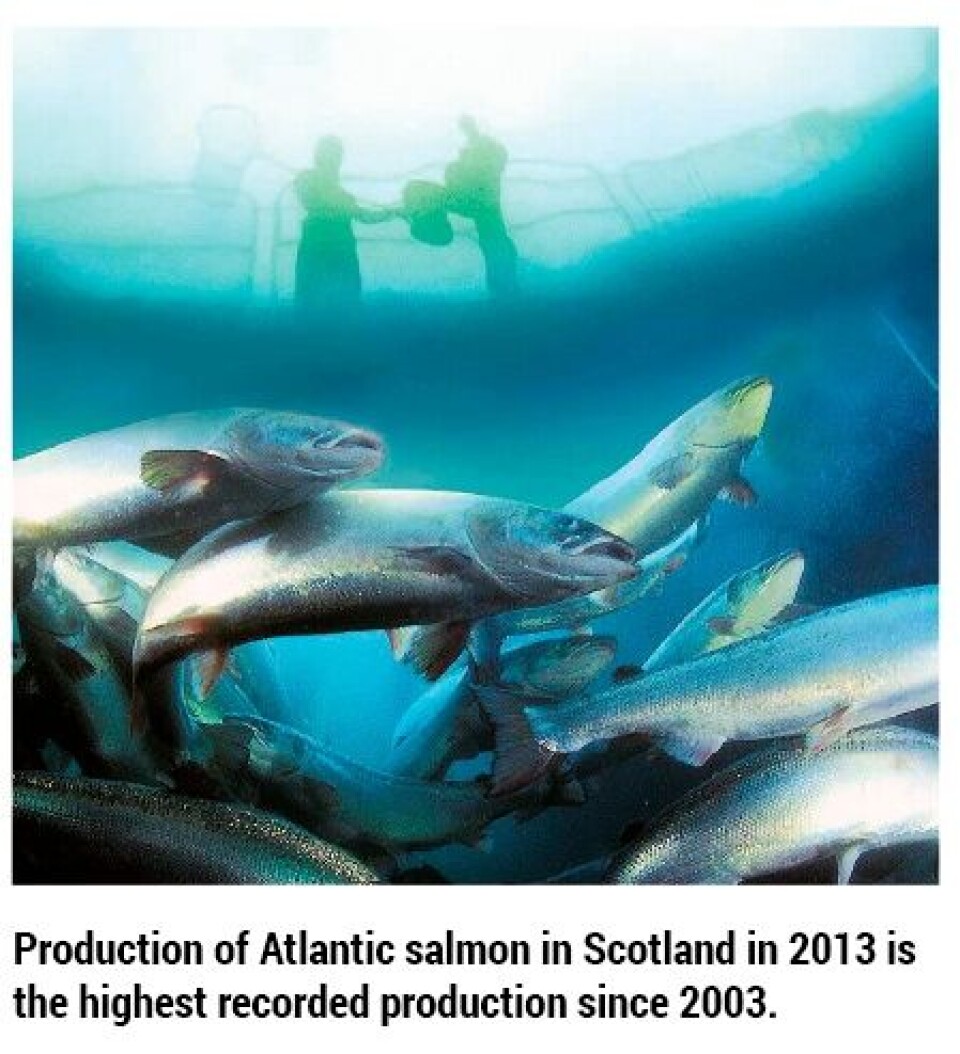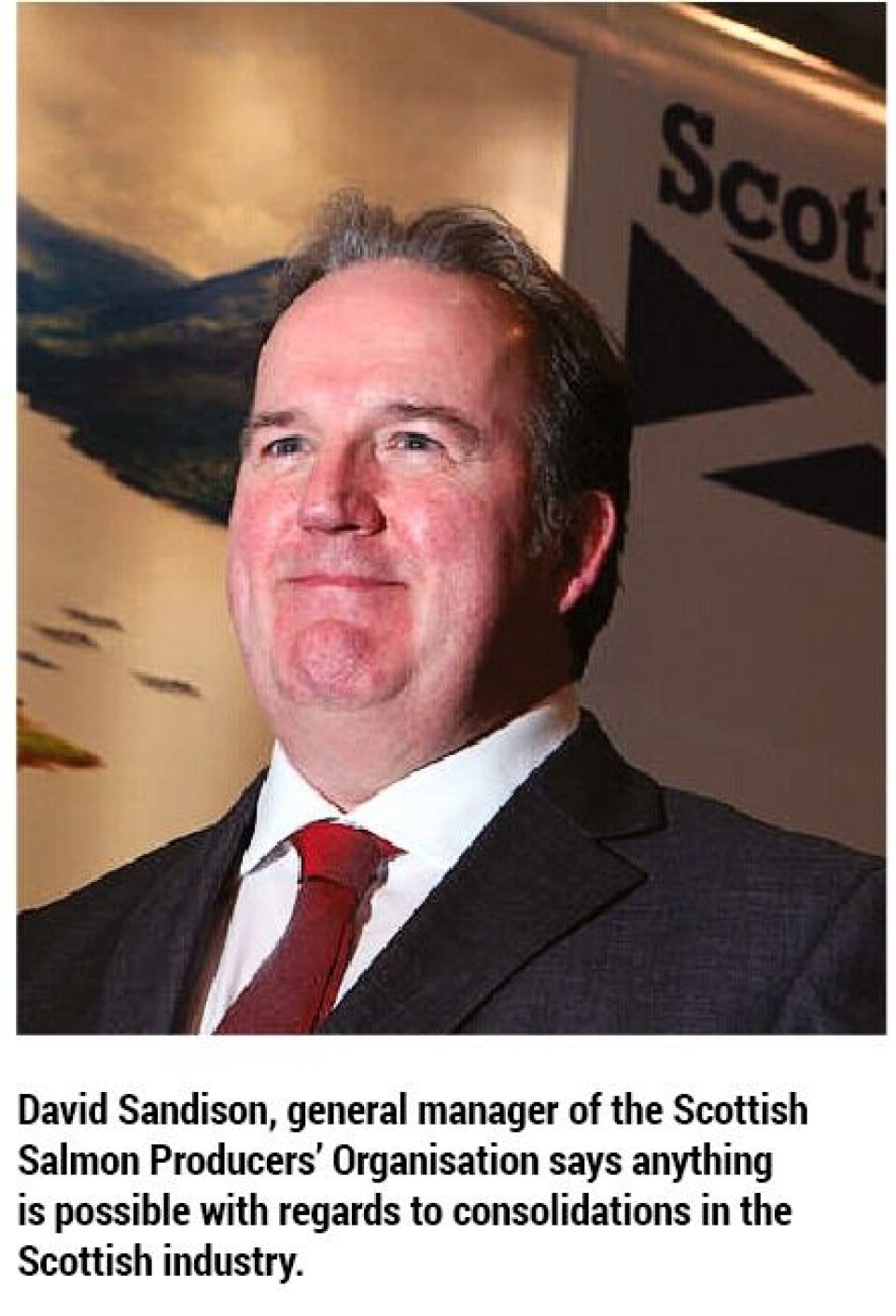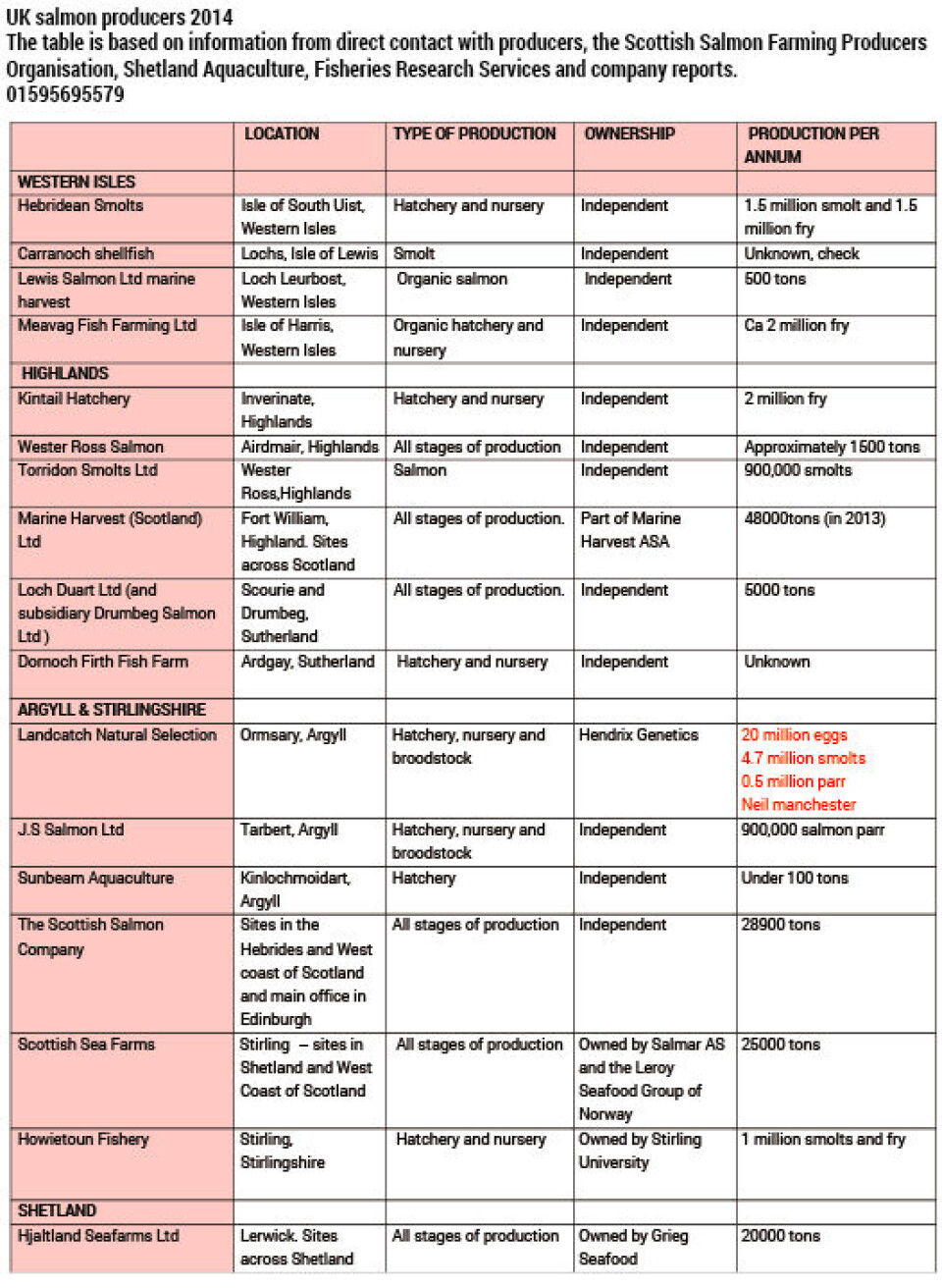The structure of the Scottish salmon farming industry in 2014
Over the last decade, a great number of businesses in Scotland have been bought up and companies have consolidated. In 2014, Marine Harvest, which had recently taken over Morpol, sold the subsidiary Meridian Salmon to the Canadian fish farming company Cooke Aquaculture. This was due to the European Commission requiring Marine Harvest to divest farming capacity on the Shetland and Orkney Islands. Further consolidations in the Scottish industry could be a possibility, but is hard to predict. “Anything is possible,” says David Sandison, general manager of the Scottish Salmon Producers’ Organisation (SSPO) and adds: “That was a major change. One year before we would not have seen that coming.” He believes consolidations will continue globally, and as many Scottish companies have foreign owners – Norwegian mostly, what happens in Norway will have a knock on effect on Scotland. However, he believes the strong merger environment is a result of the healthy value the companies currently have.

Growth According to the Scottish Fish Farm Production Survey 2013, which was published recently, production of Atlantic salmon increased by 1,011 tonnes (0.6%) in 2013 to 163,234 tonnes, which is the highest recorded production since 2003 and follows on from a 2.7% increase in 2012. The farm gate value of farmed salmon was £677 million last year, an increase of 26 per cent compared to the previous year. “Scotland’s Aquaculture sector is now estimated to be worth £1.75 billion to the Scottish economy overall. If sustained, the sector, is well on its way to generating over £2 billion annually for the Scottish economy and supporting 10,000 jobs by 2020 many of which are in some of Scotland’s most remote and rural communities,” said the Environment and Climate Change Minister Paul Wheelhouse. Sandison says an increase of perhaps 7-8 per cent in 2014 is anticipated as it is looking like this will be quite a good year with good growth and no problems with mortality levels. He expects to see a small growth year on year in the coming years. The growth target for the industry is to increase the production to 210,000 tonnes in 2020. That would mean approximately 45000 tons more in the next six years. However, Sandison points out that the main interest is in seeing the value grow and says nobody is making the target a priority. Although a number of new planning applications have been approved with several other locations identified as potential areas for development, and companies are expanding their current operation.

Growth in export Exports of Scottish salmon grew by £60 million in the first six months of the year proving that overseas demand remains high. An additional 12,000 tonnes of Scotland’s farmed salmon made its way to kitchens and dining tables around the world. Scott Landsburgh, chief executive of the Scottish Salmon Producers’ Organisation said: “This has been another strong period of growth for Scottish salmon producers and demonstrates just how important Scottish salmon has become in foreign markets and to the Scottish economy. “Industry is committed to raising the profile of Scottish salmon in new and emerging markets and I think these results are proof that we are beginning to reap the rewards. We are developing both international markets and domestic opportunities in order to ensure long-lasting business growth.” Since the beginning of the year, at a value of £10 million, Far East exports have increased by a quarter, taking their total value to a record £47 million. As trade links have grown, China has become a significant consumer of Scottish salmon, increasing from virtually nothing in 2010 to be worth almost £34 million in 2014. Closer to home, exports to the European Union grew by 50% (5,000 tonnes). Key market France grew by £20 million and Germany doubled consumption.
Five biggest producers
Marine Harvest Scotland Marine Harvest Scotland (MHS) is the leading Scottish salmon farming company. The company has four hatcheries, five freshwater loch sites and 46 sea farms situated in the Western Isles, Inner Hebrides, Wester Ross, Argyll and Inverness-shire. Live fish are harvested at Mallaig and processed at the Blar Mhor processing plant in Fort William. The head office is situated in Rosyth, Fife. In total 543employees are employed at these locations. MHS expects to harvest 45,000 (waiting) tonnes of salmon in 2014. The sale of the activities at the Shetland and Orkney Islands was completed at a sales price of GBP 122.5 million. The company was set to open new farms on the Isle of Muck in 2014 and Colonsay in 2015.
Scottish Sea Farms Norskott Havbruk AS today owns 100 per cent of Scottish Sea Farms Ltd (SSF), the second largest fish farming company in Scotland. Norskott Havbruk AS is 50 per cent owned by Lerøy Seafood Group ASA and the fish farming company SalMar ASA respectively. SSF has 66 marine sites, 5 freshwater sites and 5 hatcheries on the West Coast of Scotland and throughout the northern isles of Shetland and Orkney. In addition, it has processing in Shetland and Argyll. It employs around 380 people. The company is expecting to produce around 25000 tons in 2014.
The Scottish Salmon Company (SSC) SSC employs more than 400 staff at 60 separate sites across the Highlands and Islands and West Coast - 90 per cent of them living and working in remote rural communities. In the last three years, the company has invested £9 million in the Western Isles, spending £3.5 million with local suppliers. Production in 2014 is expected to be around 28,900 tons.
Meridian Salmon Farms Limited Earlier this year, the Canadian farming company Cooke Aquaculture closed a deal with Marine Harvest for the purchase of its fully owned subsidiary, Meridian Salmon Farms Limited. Meridian is a leading Scottish salmon farming company with assets in Shetland, Orkney and the mainland of Scotland. According to a spokesperson for Cooke Aquaculture, the company’s sites in Scotland, both freshwater and seawater, are very much the same as when Cooke bought Meridian: “The only change is that we obtained an increased consent on one of our SW sites in Orkney.” Meridian has 45 [seawater] sites in Orkney and Shetland. 23 are currently stocked with fish; the remaining sites are either fallow or waiting to be stocked with smolts. The company has12 [freshwater sites] in Shetland and the Scottish mainland and 2 packing facilities, one in Orkney and one in Shetland. The tonnage for 2014 is expected to be around 18,000 tonnes HOG. It said the current plan is to focus is on efficiencies and quality with no plan for significant growth in 2014-2015.
Grieg Seafod Hjaltland UK Ltd Grieg Seafood Hjaltland Ltd is a wholly owned subsidiary of Grieg Seafood ASA of Norway. The group consists of Hjaltland Hatcheries (smolt production); Hjaltland Seafarms (farming and production); Lerwick Fish Traders (processing) and Shetland Products (sales and marketing). In 2014 harvest is expected to be 20,000 tonne gutted weight. Sites currently active in Shetland are 22. The company is still the biggest producer in the Shetland Islands and employs approximately 200 people. Managing director Sigurd Pettersen took over temporarily as Grieg Seafood’s Shetland director after Michael Stark left in August last year after heading the Scottish operation for 14 years. Hjaltland is currently developing the new hatchery at Millbrook from where it will supply fish to its own Shetland operations and also sell them down south. The aim is that by 2016 production should have increased to five million a year to supply all of the company’s Shetland based farms.























































